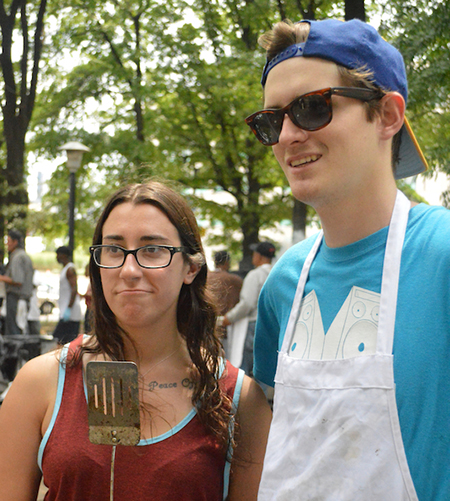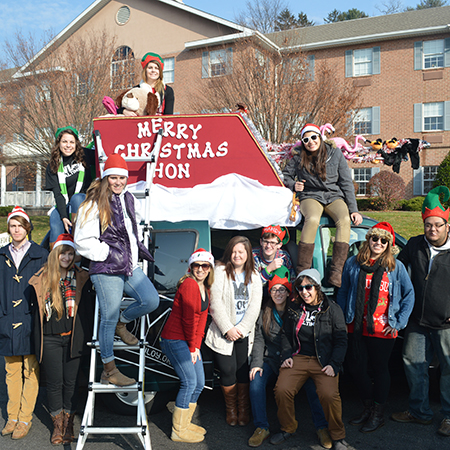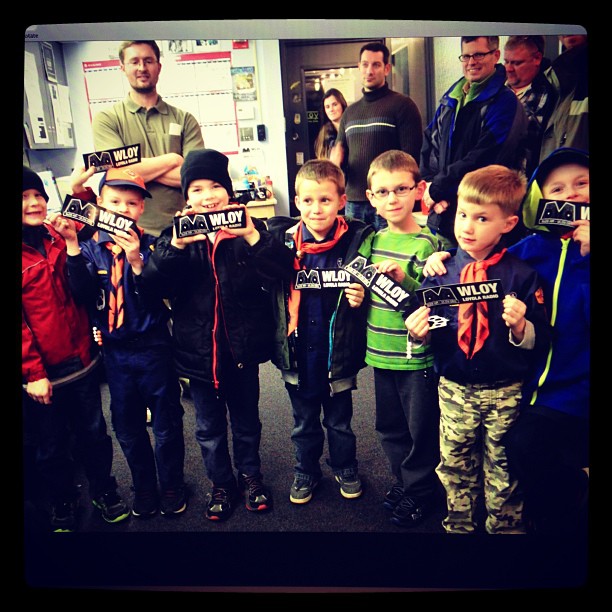Broadcasting service through Baltimore
WLOY is on the air and in the community
Late every August, students who are involved in WLOY travel into downtown Baltimore to help run the People’s Barbecue for the Homeless, held near St. Vincent de Paul Catholic Church.
The People’s Barbecue for the Homeless is an annual event co-founded by WLOY and supported by more than 25 organizations from around the city, including Loyola’s very own radio station. This charitable effort provides a nutritious and delicious meal to hundreds and hundreds of people in need on a summer day in Baltimore.
“There have been years where we stopped counting at 1,000 people,” said John Devecka, operations manager for WLOY. “It’s madness to see how bad the need is. We play music during the event, and students serve or pour or cook.”

This past summer’s event took place at the Shot Tower Park, where WLOY collaborated with 10 other community groups. In addition to serving barbecue, the groups organized and manned tables with clothing and packaged food.
Devecka borrowed a box truck from Loyola and—with a group of men who had formerly experienced homelessness—filled it with ready-made meals offered from a women’s shelter in Cecil County, Md. Ultimately, more than seven pallets of food were distributed to local organizations and at the event.
The People’s Barbecue for the Homeless is an experience that makes a difference for the community while also making an impact on the students, who throw themselves into hosting the event. They work hard alongside community partners and connect with other residents of Baltimore.
“One year a student who helped at the barbecue gave me a ride home,” Devecka said. “We got to my house, and he got really quiet. He looked at me and said, ‘That was the coolest thing I’ve ever done.’ I said, ‘There you go. That’s why we do that.’”
As a part of the Loyola community, the campus radio station sees itself as an arm of Loyola that is fully invested in the surrounding community as well.
This vision reflects that of the university as a whole. Across Loyola, students, faculty, staff, and administrators connect with organizations and businesses throughout the community, enriching the city while also being enriched through the experience of service and partnership.

Notably, the Center for Community, Service, and Justice (CCSJ) takes the lead on much of the community engagement, linking students to organizations and opportunities throughout the city and working with faculty to create servicelearning courses. The commitment to engaging the city of Baltimore extends beyond CCSJ, however; it permeates the Loyola community in numerous ways, including at WLOY.
WLOY takes that aspect of the University’s Jesuit mission seriously— and brings an energy and excitement to that work that those in the community notice. It’s even in their mission statement, which says WLOY “is committed to integrating itself into the greater Baltimore community through programming, events, and outreach.”
“We have a lot of problems in Baltimore City, and some of the solutions that are needed to fix these problems are needed on a large scale. The larger problems require big sweeping resources to affect hundreds of thousands of people,” said Baltimore City Councilman Bill Henry, MBA ’06. “But not all big problems can be addressed, so we need people who are making a small difference, even if that difference is just for a couple dozen or hundreds of people. WLOY and other community-based groups are completing projects that go under the radar, but through the work they are doing, they are improving the lives of many people.”
Henry first met Devecka when his children participated in What Happens Next?, an award-winning program WLOY has offered since 2009 to promote reading and writing skills among children.
“Since then, our relationship has expanded, and I keep finding WLOY involved in other events,” Henry said. “WLOY is living up to the Jesuit values with their involvement in the community.”
Devecka first came to Loyola in 2001 as a contractor to help set up the radio station. And he never left. Since starting at Loyola, he has sought ways to help students build those bridges to the community—and to offer lessons they will carry with them through their time at Loyola and afterward as graduates.
“You should be connected to your community if you want the radio station to do something of value for the students,” Devecka said. “Everybody can learn to spin a record and make a show, but you have to know how to engage with your community.”
Community engagement is a priority and a passion for the team at WLOY, which has responded to opportunities while also creating some of their own. For example, the creation of Both Feet In, an interview show focused on people experiencing homelessness, led to co- founding and funding Word on the Street, a newspaper for those experiencing homelessness in Baltimore, which in turn sparked the idea for the barbecue. WLOY also seeks out educational opportunities in the community, such as sending two students to Govans Elementary School every week to host What Happens Next? with children there and inviting students, like an eighth grade theater group from Roland Park Middle School, to come record their radio plays in the studio.
These moments of mentorship help the children envision educational opportunities for themselves beyond grade school, and they’re meaningful for the WLOY students, too. A new initiative that Devecka and the WLOY students are launching is the Baltimore Furniture Bank, which will offer free furniture to individuals who are transitioning from homelessness into housing. WLOY is renting a one-car garage to store the donated furniture, which includes retired furniture from Loyola residence halls. The communityminded radio station is also developing a website, www.baltimorefurniturebank. org, that will help connect people to the available furniture.
Devecka is always impressed with how Loyola students embrace opportunities to serve and connect with the community.
“Before we started a radio show to interview people experiencing homelessness, I took the idea to the students and said, ‘Do you want to have this on the air?’, and I was amazed it was universally and enthusiastically accepted,” he said. “That’s very much a tribute to the kind of students we have here. They’re much more open to engagement and the understanding that they have some community obligation.”
It’s not just a sense of obligation, though. WLOY also has fun. The students participate in community events such as HonFest and the Mayor’s Annual Christmas Parade in Baltimore’s Hampden neighborhood. This year at the parade, the students dressed up as Charlie Brown characters and handed out 2,500 candy canes to the children on the sidewalks as they passed. Loyola is the only college or university that marches— invited because of the radio station’s presence in the community—and WLOY always brings a float.
Tim Teeling, ’11, remembers helping construct a float for the parade one year that featured flamingos pulling a sleigh on the top of the WLOY station van.
“WLOY got me involved in the local community from the very start. My first weekend on the job I was working the tent on The Avenue at Hampdenfest,” said Teeling, who lives in Odenton, Md., and works as a web designer with Tenable, a cybersecurity firm in Columbia, Md. “WLOY has always been about showcasing local music, but also about bettering the local community.”

During her time at Loyola, Alex Fili, ’13, started as WLOY’s event coordinator and moved on to serving as business manager. The highlight of her time at WLOY, however, was directing What Happens Next?
“WLOY taught me how to work hard, time-management skills, how to work well with others who are not just in your major, and the importance of giving back,” said Fili, who is planning to graduate from dental school at Boston University School of Dental Medicine in May. “I pride myself on being a dentist who is able to communicate and connect with my patients in more than just a doctor-patient relationship. WLOY helped me interact with so many different people at Loyola and in the surrounding Baltimore community. WLOY was way more than a radio station—in fact, that might have been just the basis of what we were. But really, the emphasis was placed on reaching out to the community and giving back in any way possible.”
Michael Ashley-Mennis, ’10, is grateful that WLOY taught him how to work with the sound equipment and systems he uses today in his work as a teacher in Norwalk, Calif. He also learned about seeking a way to serve others and joined the Jesuit Volunter Corps after graduation, working in California and Alaska in shelters helping women who had survived domestic violence.
“One thing I truly loved about WLOY was how much it always looked outward for opportunities to help the community. From working with WLOY on expanding radio and production in Baltimore schools, and running a radio camp for kids where we helped students produce their own radio segments, to educating others on finance and serving those experiencing homelessness, the station always felt like it was looking to be a community station as much as it was a station for Loyola students,” AshleyMennis said. “WLOY inspired and encouraged me to continue to pursue a path of service.”
Before WLOY students graduate, Devecka tries to make sure they appreciate that they should carry this sense of community engagement with them in the future.
“When you go work for WXYZ Radio— or any business—in whatever town, you have to understand there’s more going on than just in your studio,” he said. “We have to invest in helping people.”
One year, as the students were serving food at the People’s Barbecue for the Homeless, one of them turned to Devecka.
“How do you know everyone in line is homeless?” the student asked. “If someone is willing to wait in line for two hours for a free hot dog, they need a hot dog,” Devecka told him. “There’s no one in line who doesn’t need the food. The need is clear and substantial. We’re not here for judgment, we’re here to feed people.”
And feed people they do—with music and in so many other ways.